Las Malgrats are a group of two islands and a small stack off the south coast of the tourist locality of Calvià, on the west coast of the bay of Palma de Mallorca, Balearic Islands, Spain in the western Mediterranean. The largest island is Malgrats (88 ha, maximum height 64 m). Conills is 11 ha in size with a maximum height of 29 m. Conills lies 191 m off the coast of Mallorca, and Malgrats is 91 m off Conills. Foradada is a small barren rock 21 m off the coast of Mallorca. The islands support low scrubland with plants adapted to seabird guano.

Malgrats from Mallorca (left Malgrats and right Conills). The touristic built-up area of Calvià can be seen along the coast
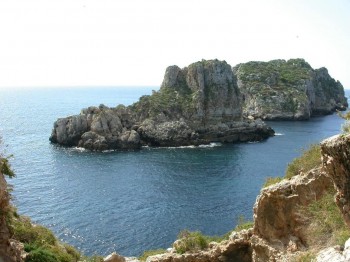
Malgrats from Conills
The limestone Malgrats Island contains a large number of crevices and small caves with high sea cliffs on the northern side. The islands have never been inhabited and their rugged terrain and difficult access deter visitors. During the last century the Malgrats were used for artillery practice.
Both islands support ideal nesting habitat for the ACAP-listed and Critically Endangered Balearic Shearwater Puffinus mauretanicus with 250 pairs on Malgrats, and 50 on Conills in 2009. The breeding colony of Malgrats was discovered in the 1980s although local fishers used to exploit the shearwaters in the 1940s during the hard years following Spain’s Civil War.
Scopoli’s Shearwaters Calonectris diomedea breed in small numbers on Malgrats and Conills. Mediterranean Storm Petrels Hydrobates pelagicus melitensis have been observed visiting Balearic Shearwater caves but breeding has not been recorded.
Black Rats Rattus rattus (50/ha in the late 1980s) and European Rabbits Oryctolagus cuniculatus (now extinct) were once common on the islands - in Catalan conill means rabbit. Balearic Shearwaters then only bred in small coastal caves and in some breeding success was quite low. In 1987 bait stations were laid out on the islands to control the rats, the first time in the Balearics. In 2006/07 hand broadcasting poison bait successfully eradicating the rats. Because the Malgrats Islands are very close to Mallorca reinvasions are likely to occur.

Balearic Shearwater in its breeding cave, photograph by Daniel Oro
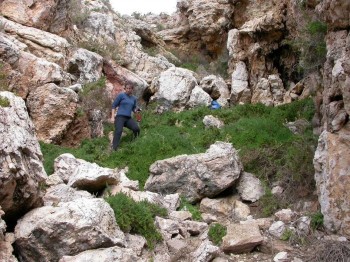
This boulder screen on Conills was once a large cave, the large boulders were part of the cave's roof.
Balearic Shearwaters only started to breed on Conills after rats were eradicated in 2007
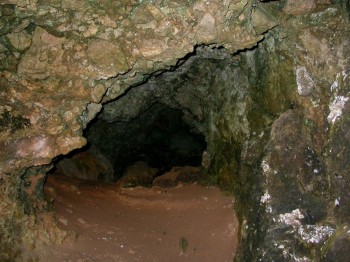
Three pairs of Balearic Shearwaters breed in this small cave on Conills. Balearic Shearwaters only breed in caves and crevices with soft sediment covering the floor, laying their eggs in small depressions dug out in the sediment
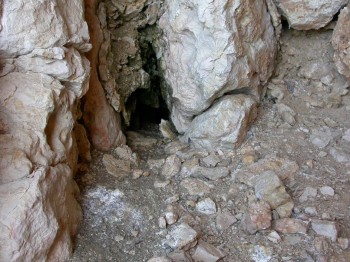
A Balearic Shearwater crevice on Malgrats; guano can be observed near the entrance
The islands form a Special Protection Area (SPA) and are fully protected, but as yet do not have a management plan. Rodent presence has not been monitored since 2009. The surrounding sea makes up the Illes Malgrats Marine Reserve declared in 2004.
Malgrats lies off the coast of one of the most important tourist destinations in Mallorca. Light pollution is increasing along the nearby coast, and is a potential threat to Balearic Shearwaters breeding on Malgrats. Light pollution from street lights should be reduced in coastal areas near the shearwater colonies.

Malrats and Conills
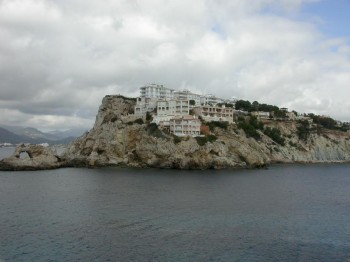
The coast of Mallorca from Conills. Fallouts of fledged Balearic Shearwaters are common along this coast
References:
Aguilar, J.S. & Cózar, E. 1989. Campaña de desratización en los islotes de Malgrats y su posible incidencia en la avifauna nidificante. In: López-Jurado, C. (Ed.). Actas de la IV Reunión del Grupo Ibérico de Aves Marinas, Sant Francesc Xavier de Formentera 29 de Octubre al 1 de Noviembre de 1988. Palma de Mallorca: Grup Balear d'Ornitologia i Defensa de la Naturalesa. pp. 55-60
Arcos, J.M. 2011. International Species Action Plan for the Balearic Shearwater, Puffinus mauretanicus. Madrid: SEO/BirdLife & BirdLife International. 51 pp.
Capellà, L. 1989. Observaciones sobre la Pardela Pichoneta Puffinus mauretanicus de las Baleares. In: López-Jurado, C. (Ed.). Actas de la IV Reunión del Grupo Ibérico de Aves Marinas, Sant Francesc Xavier de Formentera 29 de Octubre al 1 de Noviembre de 1988. Palma de Mallorca: Grup Balear d'Ornitologia i Defensa de la Naturalesa. pp. 61-67.
McMinn, M. & Rodríguez, SA. 2010. Islas, ratas y aves: historias de éxtos y fracasos. In: Álvarez, C. (Ed.). Seminari sobre espècies introduïdes i invasores a les Illes Balears. Sóller: Govern de les Illes Balears, Conselleria de Medi Ambient i Mobilitat. pp. 115-126.
Oliver Ramón D. & Vera Mas, B. 2010. La mar quotidiana. Cartes d'un pescador. Palma de Mallorca: Miquel Font Editor.
Rodríguez, A., García, D., Rodríguez, B., Cardona, E., Parpal, L. & Pons, P. 2015. Artificial lights and seabirds: is light pollution a threat for the threatened Balearic petrels? Journal of Ornithology 156: 893-902.
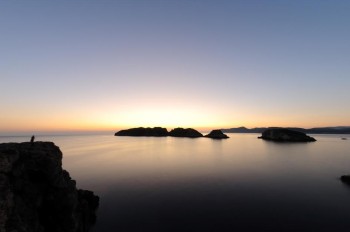
Sunset over Malgrats
Landscape photographs from Miguel McMinn
Miguel McMinn, Skua Gabinet d'Estudis Ambientals SLP, Mallorca, Spain 20 June 2016

 English
English  Français
Français  Español
Español